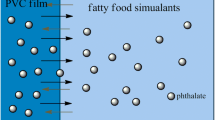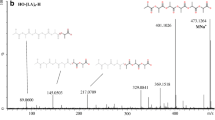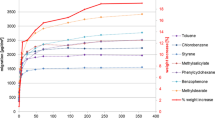Abstract
The specific migration of [2,2-bis(4 hydroxyphenyl) propane] from polycarbonate films into ethanol 50 % food simulant was studied. A phenomenological model based on a resistances-in-series system was resolved through the regula falsi algorithm. The diffusion–convection model was not able to describe the BPA concentration change as a function of time after 40 h, since an equilibrium condition with a plateau is not achieved. BPA generation due to PC hydrolysis produces an increase in BPA concentration. The continuous generation of BPA can be described by a generation–diffusion–convection model, where BPA generation obeys to a pseudo-zero-order reaction.





Similar content being viewed by others
References
Wagner M, Oehlmann J (2009) Endocrine disruptors in bottled mineral water: total estrogenic burden and migration from plastic bottles. Environ Sci Pollut Res 16:278–286
Hoekstra EJ, Simoneau C (2013) Release of bisphenol A from polycarbonte—a review. Crit Rev Food Sci Nutr 53(4):386–402
Mercea P (2009) Physicochemical processes involved in migration of bisphenol a from polycarbonate. J Appl Polym Sci 112:579–593
Nam S, Seo Y, Kim M (2010) Bisphenol A migration from polycarbonate baby bottle with repeated use. Chemosphere 79:949–952
Santillana MI, Ruiz E, Nieto MT, de Quirós ARB, Sendón R, Cirugeda ME, Sanchez JJ (2013) Polycarbonate baby bottles: study of the release of bisphenol A. Eur Food Res Technol 236:883–889
De Coensel N, David F, Sandra P (2009) Study on the migration of bisphenol-A from baby bottles by stir bar sorptive extraction–thermal desorption–capillary GC–MS. J Sep Sci 32(21):3829–3836
Erler C, Novak J (2010) Bisphenol A exposure: human risk and health policy. J Pediatr Nurs 25(5):400–407
EC (2011) EU directive no. 2011/10/EC relating to plastics materials and articles intended to come into contact with foodstuffs. Off J L12:1–89
Kawamura Y, Koyama Y, Takeda Y, Yamada T (1998) Migration of bisphenol A from polycarbonate products. J Food Hyg Soc Jpn 99:206–212
Dopico-García MS, López-Vilariño JM, González-Rodríguez MV (2006) Effect of temperature and type of food simulant on antioxidant stability. J Appl Polym Sci 100:656–663
Galotto MJ, Torres A, Guarda A, Moraga N, Romero J (2011) Experimental and theoretical study of LDPE versus different concentrations of Irganox 1076 and different thickness. Food Res Int 44:566–574
CEN ENV 1186-1 (1993) Materials and articles in contact with foodstuffs—plastics substances subject to limitation. Part 1: guide to the selection of conditions and test methods for overall migration
CEN ENV 13130-1 (2005) Materials and articles in contact with foodstuffs—plastics substances subject to limitation. Part 1: guide to test methods for the specific migration of substances from plastics to foods and food simulants and the determination of substances in plastics and the selection of conditions of exposure to food simulants
Torres A, Guarda A, Moraga N, Romero J, Galotto MJ (2012) Experimental and theoretical study of thermodynamics and transport properties of multilayer polymeric food packaging. Eur Food Res Technol 234(4):713–722
Ballesteros-Gómez A, Rubio S, Pérez-Bendito D (2009) Analytical methods for the determination of bisphenol A in food: a review. J Chromatogr A 1216:449–469
Bair HE, Falcone DR, Hellman MY, Johnson GE, Kelleher PG (1981) Hydrolysis of polycarbonate to yield BPA. J Appl Polym Sci 26:1777–1786
Deirram N, Rahmat AR, Rashidi S, Ghanbari T, Moradpour M (2012) Hydrolysis degradation of polycarbonate under microwave irradiation by using design of experiment software. Sci Res Essay 7:3399–3405
Ehlert KA, Beumer CWE, Groot MCE (2008) Migration of bisphenol A into water fron polycarbonate baby bottles during microwave heating. Food Addit Contam 25(7):904–910
Wright DC (2001) Failure of polymer products due to chemical attack. Smithers Rapra Publishing, UK
Crank J (1975) The mathematical of diffusion, 2nd edn. Clarendon Press, London
Torres A, Romero J, Macan A, Guarda A, Galotto MJ (2014) Near critical and supercritical impregnation and kinetic release of thymol in LLDPE films used for food packaging. J Supercrit Fluids 85:41–48
Galotto MJ, Torre A, Guarda A, Moraga N, Romero J (2011) Experimental and theoretical study of LDPE: evaluation of different food simulants and temperatures. Food Res Int 44:3072–3078
Song X, Liu F, Li L, Yang X, Yu S, Ge X (2013) Hydrolysis of polycarbonate catalyzed by ionic liquid [Bmim][Ac]. J Hazard Mater 244–245:204–208
Helmroth E, Rijk R, Dekker M, Jongen. w (2002) Predictive modelling of migration from packaging materials into food products for regulatory purposes. Trends Food Sci Technol 13:102–109
Delpech M, Coutinho F, Habibe M (2002) Bisphenol A-based polycarbonates: characterization of commercial samples. Polym Test 21:155–161
Jang L, Lee D (2000) Polystyrene/bisphenol A polycarbonate molecular composite by in situ polymerization. I. Preparation and characterization. Polymer 4:1749–1756
Islam MM, Seo D-W, Jang H-H, Lim Y-D, Shin KM, Kim WG (2011) Synthesis and characterization of branched bisphenol-A polycarbonates functionalized with Siloxane. Macromol Res 19:1278–1286
Billmeyer F (1975) Ciencia de los polímeros. Editorial Reverté, Barcelona
Yoon Y, Westerhoff P, Snyder S, Esparza M (2003) HPLC-fluorescence detection and adsorption of bisphenol A, 17β-estradiol, and 17α-ethynyl estradiol on powdered activated carbon. Water Res 37:3530–3537
Silverstein R, Webster F, Kiemle D (2005) Spectrometric identification of organic compounds. Wiley, New York
Poustková I, Dobiás J, Steiner I, Poustka J, Voldrich M (2004) Stability of bisphenol A diglycidyl ether and bisphenol F diglycidyl ether in water-based food simulants. Eur Food Res Technol 219:534–539
Crosby NT (1981) Food packaging materials: aspects of analysis and migration of contaminants. Applied Science Publishers, London
Acknowledgments
The authors thank the National Commission for Scientific and Technological Research (CONICYT), for its financial support from the National Fund for Scientific and Technological Development, FONDECYT [Grant No. 1120368], FONDEF Project D09I1043, “Propuesta Científica de Normativa para el Desarrollo de Envases Plásticos Inocuos: Una Metodología Científica Tecnológica de Apoyo a Instituciones Públicas y Privadas para Fortalecer la Estrategia Nacional de Consolidación de la Industria Alimentaria”, and for its financial support of Basal Financing Program Science and Technological Centers of Excellence [Grant No. F0807].
Conflict of interest
None.
Compliance with Ethics Requirements
This article does not contain any studies with human or animal subjects.
Author information
Authors and Affiliations
Corresponding author
Rights and permissions
About this article
Cite this article
Torres, A., Ramirez, C., Romero, J. et al. Experimental and theoretical study of bisphenol A migration from polycarbonate into regulated EU food simulant. Eur Food Res Technol 240, 335–343 (2015). https://doi.org/10.1007/s00217-014-2333-6
Received:
Revised:
Accepted:
Published:
Issue Date:
DOI: https://doi.org/10.1007/s00217-014-2333-6




